Chrono::GPU: An Open-Source Simulation Package for Granular Dynamics Using the Discrete Element Method
Abstract
:1. Introduction: State of the Art
2. The DEM Model
3. Aspects Related to the Design of the Software
3.1. Mixed Data Types
3.2. Domain Decomposition and Local Coordinates
3.3. Co-Simulation
3.4. Checkpointing
4. Validation Tests
4.1. Small-Scale Tests
4.1.1. Oblique Impact
4.1.2. Sphere Stacking
4.1.3. Wave Propagation
4.2. Benchmark Tests
4.2.1. Direct Shear Test
4.2.2. Cratering Test
4.2.3. Low-Velocity Cratering Test
4.2.4. Rotating Drum
5. Scaling Analysis
6. Demonstration of Technology: Rover Mobility Simulations
7. Conclusions
Author Contributions
Funding
Institutional Review Board Statement
Informed Consent Statement
Data Availability Statement
Acknowledgments
Conflicts of Interest
References
- Cundall, P.A.; Strack, O.D. A discrete numerical model for granular assemblies. Geotechnique 1979, 29, 47–65. [Google Scholar] [CrossRef]
- Pöschel, T.; Schwager, T. Computational Granular Dynamics: Models and Algorithms; Springer: Berlin/Heidelberg, Germany, 2005. [Google Scholar]
- Lemieux, M.; Léonard, G.; Doucet, J.; Leclaire, L.A.; Viens, F.; Chaouki, J.; Bertrand, F. Large-scale numerical investigation of solids mixing in a V-blender using the discrete element method. Powder Technol. 2008, 181, 205–216. [Google Scholar] [CrossRef]
- Apostolou, K.; Hrymak, A. Discrete element simulation of liquid-particle flows. Comput. Chem. Eng. 2008, 32, 841–856. [Google Scholar] [CrossRef]
- Tang, C.L.; Hu, J.C.; Lin, M.L.; Angelier, J.; Lu, C.Y.; Chan, Y.C.; Chu, H.T. The Tsaoling landslide triggered by the Chi-Chi earthquake, Taiwan: Insights from a discrete element simulation. Eng. Geol. 2009, 106, 1–19. [Google Scholar] [CrossRef]
- Salciarini, D.; Tamagnini, C.; Conversini, P. Discrete element modeling of debris-avalanche impact on earthfill barriers. Phys. Chem. Earth, Parts A/B/C 2010, 35, 172–181. [Google Scholar] [CrossRef]
- Sánchez, P.; Scheeres, D.J. Simulating asteroid rubble piles with a self-gravitating soft-sphere distinct element method model. Astrophys. J. 2011, 727, 120. [Google Scholar] [CrossRef]
- Amritkar, A.; Deb, S.; Tafti, D. Efficient parallel CFD-DEM simulations using OpenMP. J. Comput. Phys. 2014, 256, 501–519. [Google Scholar] [CrossRef]
- Yan, B.; Regueiro, R.A. A comprehensive study of MPI parallelism in three-dimensional discrete element method (DEM) simulation of complex-shaped granular particles. Comput. Part. Mech. 2018, 5, 553–577. [Google Scholar] [CrossRef]
- Checkaraou, A.W.M.; Rousset, A.; Besseron, X.; Varrette, S.; Peters, B. Hybrid mpi+ openmp implementation of extended discrete element method. In Proceedings of the 2018 30th International Symposium on Computer Architecture and High Performance Computing (SBAC-PAD), Lyon, France, 24–27 September 2018; pp. 450–457. [Google Scholar]
- Xu, J.; Qi, H.; Fang, X.; Lu, L.; Ge, W.; Wang, X.; Xu, M.; Chen, F.; He, X.; Li, J. Quasi-real-time simulation of rotating drum using discrete element method with parallel GPU computing. Particuology 2011, 9, 446–450. [Google Scholar] [CrossRef]
- Govender, N.; Wilke, D.; Kok, S. Blaze-DEMGPU: Modular high performance DEM framework for the GPU architecture. SoftwareX 2016, 5, 62–66. [Google Scholar] [CrossRef] [Green Version]
- Iwashita, K.; Oda, M. Rolling resistance at contacts in simulation of shear band development by DEM. J. Eng. Mech. 1998, 124, 285–292. [Google Scholar] [CrossRef]
- Renzo, A.D.; Maio, F.P.D. Comparison of contact-force models for the simulation of collisions in DEM-based granular flow codes. Chem. Eng. Sci. 2004, 59, 525–541. [Google Scholar] [CrossRef]
- Da Cruz, F.; Emam, S.; Prochnow, M.; Roux, J.N.; Chevoir, F. Rheophysics of dense granular materials: Discrete simulation of plane shear flows. Phys. Rev. E 2005, 72, 021309. [Google Scholar] [CrossRef] [PubMed] [Green Version]
- Rycroft, C.H.; Grest, G.S.; Landry, J.W.; Bazant, M.Z. Analysis of granular flow in a pebble-bed nuclear reactor. Phys. Rev. E 2006, 74, 021306. [Google Scholar] [CrossRef] [PubMed] [Green Version]
- Kruggel-Emden, H.; Sturm, M.; Wirtz, S.; Scherer, V. Selection of an appropriate time integration scheme for the discrete element method (DEM). Comput. Chem. Eng. 2008, 32, 2263–2279. [Google Scholar] [CrossRef]
- Wasfy, T.M.; Wasfy, H.M.; Peters, J.M. Coupled Multibody Dynamics and Discrete Element Modeling of Vehicle Mobility on Cohesive Granular Terrains. In Proceedings of the ASME 2014 International Design Engineering Technical Conferences and Computers and Information in Engineering Conference, Buffalo, NY, USA, 17–20 August 2014; American Society of Mechanical Engineers: New York, NY, USA; p. V006T10A050. [Google Scholar]
- Lommen, S. DEM speedup: Stiffness effects on behavior of bulk material. Particuology 2014, 12, 107–112. [Google Scholar] [CrossRef]
- Utili, S.; Zhao, T.; Houlsby, G. 3D DEM investigation of granular column collapse: Evaluation of debris motion and its destructive power. Eng. Geol. 2015, 186, 3–16. [Google Scholar] [CrossRef] [Green Version]
- Potticary, M.; Zervos, A.; Harkness, J. An investigation into the effect of particle platyness on the strength of granular material using the discrete element method. In Proceedings of the IV International Conference on Particle-based Methods—Fundamentals and Applications, Barcelona, Spain, 28–30 September 2015. [Google Scholar]
- Michael, M.; Vogel, F.; Peters, B. DEM-FEM coupling simulations of the interactions between a tire tread and granular terrain. Comput. Methods Appl. Mech. Eng. 2015, 289, 227–248. [Google Scholar] [CrossRef]
- Ciantia, M.; Arroyo, M.; Butlanska, J.; Gens, A. DEM modelling of cone penetration tests in a double-porosity crushable granular material. Comput. Geotech. 2016, 73, 109–127. [Google Scholar] [CrossRef]
- Zheng, Z.; Zang, M. Numerical Simulations of the Interactions Between a Pneumatic Tire and Granular Sand by 3D DEM-FEM. In Proceedings of the 7th International Conference on Discrete Element Methods, Dalian, China, 1–4 August 2016; pp. 289–300. [Google Scholar]
- Parteli, E.; Poschel, T. Particle-based simulation of powder application in additive manufacturing. Powder Technol. 2016, 288, 96–102. [Google Scholar] [CrossRef]
- Kivugo, R. Tire-Soil Interaction for Off-Road Vehicle Applications. Ph.D. Thesis, Politecnico di Milano, Milan, Italy, 2017. [Google Scholar]
- Calvetti, F.; Prisco, C.; Vairaktaris, E. DEM assessment of impact forces of dry granular masses on rigid barriers. Acta Geotech. 2016, 12, 129–144. [Google Scholar] [CrossRef]
- Cleary, P.; Sawley, M. DEM modelling of industrial granular flows: 3D case studies and the effect of particle shape on hopper discharge. Appl. Math. Model. 2002, 26, 89–111. [Google Scholar] [CrossRef]
- Bertrand, F.; Leclaire, L.; Levecque, G. DEM-based models for the mixing of granular materials. Chem. Eng. Sci. 2005, 60, 2517–2531. [Google Scholar] [CrossRef]
- Bouffard, J.; Bertrand, F.; Chaouki, J.; Dumont, H. Discrete element investigation of flow patterns and segregation in a spheronizer. Comput. Chem. Eng. 2013, 49, 170–182. [Google Scholar] [CrossRef]
- Kloss, C.; Goniva, C.; Hager, A.; Amberger, S.; Pirker, S. Models, algorithms and validation for opensource DEM and CFD–DEM. Prog. Comput. Fluid Dyn. Int. 2012, 12, 140–152. [Google Scholar] [CrossRef]
- Gropp, W.; Lusk, E.; Skjellum, A. Using MPI: Portable Parallel Programming with the Message-Passing Interface, 2nd ed.; MIT Press: Cambridge, MA, USA, 1999. [Google Scholar]
- Alizadeh, E.; Bertrand, F.; Chaouki, J. Comparison of DEM results and Lagrangian experimental data for the flow and mixing of granules in a rotating drum. AIChE J. 2014, 60, 60–75. [Google Scholar] [CrossRef]
- Gan, J.; Zhou, Z.; Yu, A. A GPU-based DEM approach for modeling of particulate systems. Powder Technol. 2016, 301, 1172–1182. [Google Scholar] [CrossRef]
- Hou, Q.; Dong, K.; Yu, A. DEM study of the flow of cohesive particles in a screw feeder. Powder Technol. 2014, 256, 529–539. [Google Scholar] [CrossRef]
- He, Y.; Evans, T.; Yu, A.; Yang, R. A GPU-based DEM for modeling large scale powder compaction with wide size distributions. Powder Technol. 2018, 333, 219–228. [Google Scholar] [CrossRef]
- Toson, P.; Siegmann, E.; Trogrlic, M.; Kureck, H.; Khinast, J.; Jajcevic, D.; Doshi, P.; Blackwood, D.; Bonnassieux, A.; Daugherity, P.D.; et al. Detailed modeling and process design of an advanced continuous powder mixer. Int. J. Pharm. 2018, 552, 288–300. [Google Scholar] [CrossRef] [PubMed]
- Fleischmann, J.; Serban, R.; Negrut, D.; Jayakumar, P. On the importance of displacement history in soft-body contact models. J. Comput. Nonlinear Dyn. 2016, 11, 044502. [Google Scholar] [CrossRef] [Green Version]
- Longmore, J.P.; Marais, P.; Kuttel, M.M. Towards realistic and interactive sand simulation: A GPU-based framework. Powder Technol. 2013, 235, 983–1000. [Google Scholar] [CrossRef]
- Ucgul, M.; Fielke, J.; Saunders, C. Three-dimensional discrete element modeling (DEM) of tillage: Accounting for soil cohesion and adhesion. Biosyst. Eng. 2015, 129, 298–306. [Google Scholar] [CrossRef]
- Ucgul, M.; Saunders, C.; Fielke, J. Comparison of the discrete element and finite element methods to model the interaction of soil and tool cutting edge. Biosyst. Eng. 2018, 169, 199–208. [Google Scholar] [CrossRef]
- Recuero, A.M.; Serban, R.; Peterson, B.; Sugiyama, H.; Jayakumar, P.; Negrut, D. A high-fidelity approach for vehicle mobility simulation: Nonlinear finite element tires operating on granular material. J. Terramech. 2017, 72, 39–54. [Google Scholar] [CrossRef]
- Zhao, C.L.; Zang, M.Y. Application of the FEM/DEM and alternately moving road method to the simulation of tire-sand interactions. J. Terramech. 2017, 72, 27–38. [Google Scholar] [CrossRef]
- Johnson, J.B.; Kulchitsky, A.V.; Duvoy, P.; Iagnemma, K.; Senatore, C.; Arvidson, R.E.; Moore, J. Discrete element method simulations of Mars Exploration Rover wheel performance. J. Terramech. 2015, 62, 31–40. [Google Scholar] [CrossRef] [Green Version]
- Furuichi, M.; Nishiura, D.; Asai, M.; Hori, T. The first real-scale DEM simulation of a sand-box experiment using 2.4 billion particles. In Proceedings of the International Conference for High Performance Computing, Networking, Storage and Analysis, Denver, CO, USA, 12–17 November 2017. [Google Scholar]
- Furuichi, M.; Nishiura, D.; Kuwano, O.; Bauville, A.; Hori, T.; Sakaguchi, H. Arcuate stress state in accretionary prisms from real-scale numerical sandbox experiments. Nat. Sci. Rep. 2018, 8, 1–11. [Google Scholar] [CrossRef]
- Nishiura, D.; Sakaguchi, H.; Yamamoto, S. Multibillion particle DEM to simulate centrifuge model tests of geomaterials. In Physical Modelling in Geotechnics, Volume 1: Proceedings of the 9th International Conference on Physical Modelling in Geotechnics (ICPMG 2018), London, UK, 17–20 July 2018; CRC Press: Boca Raton, FL, USA, 2018; p. 227. [Google Scholar]
- Strohmaier, E.; Dongarra, J.; Simon, H.; Meuer, M. TOP500 Supercomputer Site. Available online: http://www.top500.org (accessed on 7 October 2021).
- Tasora, A.; Negrut, D.; Anitescu, M. GPU-Based Parallel Computing for the Simulation of Complex Multibody Systems with Unilateral and Bilateral Constraints: An Overview. In Multibody Dynamics; Arczewski, K., Blajer, W., Fraczek, J., Wojtyra, M., Eds.; Springer: Berlin/Heidelberg, Germany, 2011; Volume 23, pp. 283–307. [Google Scholar] [CrossRef]
- Mindlin, R.; Deresiewicz, H. Elastic spheres in contact under varying oblique forces. J. Appl. Mech. 1953, 20, 327–344. [Google Scholar] [CrossRef]
- Brilliantov, N.V.; Spahn, F.; Hertzsch, J.M.; Pöschel, T. Model for collisions in granular gases. Phys. Rev. E 1996, 53, 5382. [Google Scholar] [CrossRef] [PubMed] [Green Version]
- Silbert, L.; Ertaş, D.; Grest, G.; Halsey, T.; Levine, D.; Plimpton, S. Granular flow down an inclined plane: Bagnold scaling and rheology. Phys. Rev. E 2001, 64, 051302. [Google Scholar] [CrossRef] [PubMed] [Green Version]
- Hertz, H. Ueber die Verdunstung der Flüssigkeiten, insbesondere des Quecksilbers, im luftleeren Raume. Ann. Phys. 1882, 253, 177–193. [Google Scholar] [CrossRef] [Green Version]
- Johnson, K.L. Contact Mechanics; Cambridge University Press: Cambridge, UK, 1987. [Google Scholar]
- Baboulin, M.; Buttari, A.; Dongarra, J.; Kurzak, J.; Langou, J.; Langou, J.; Luszczek, P.; Tomov, S. Accelerating scientific computations with mixed precision algorithms. Comput. Phys. Commun. 2009, 180, 2526–2533. [Google Scholar] [CrossRef] [Green Version]
- Hockney, R.; Eastwood, J. Computer Simulation Using Particles; CRC Press: Boca Raton, FL, USA, 1988. [Google Scholar]
- NVIDIA Corporation. Compute Unified Device Architecture Toolkit Documentation. Available online: https://docs.nvidia.com/cuda (accessed on 7 October 2021).
- Tasora, A.; Serban, R.; Mazhar, H.; Pazouki, A.; Melanz, D.; Fleischmann, J.; Taylor, M.; Sugiyama, H.; Negrut, D. Chrono: An open source multi-physics dynamics engine. In High Performance Computing in Science and Engineering—Lecture Notes in Computer Science; Kozubek, T., Ed.; Springer: Berlin/Heidelberg, Germany, 2016; pp. 19–49. [Google Scholar]
- Fang, L.; Zhang, R.; Negrut, D. On the Validation of Chrono::GPU. In Technical Report TR-2021-05, Simulation-Based Engineering Laboratory; University of Wisconsin-Madison: Madison, WI, USA, 2021. [Google Scholar]
- Mazhar, H.; Heyn, T.; Pazouki, A.; Melanz, D.; Seidl, A.; Bartholomew, A.; Tasora, A.; Negrut, D. Chrono: A parallel multi-physics library for rigid-body, flexible-body, and fluid dynamics. Mech. Sci. 2013, 4, 49–64. [Google Scholar] [CrossRef] [Green Version]
- Pazouki, A.; Kwarta, M.; Williams, K.; Likos, W.; Serban, R.; Jayakumar, P.; Negrut, D. Compliant contact versus rigid contact: A comparison in the context of granular dynamics. Phys. Rev. E 2017, 96, 042905. [Google Scholar] [CrossRef] [PubMed] [Green Version]
- Wu, C.Y.; Thornton, C.; Li, L.Y. Coefficients of restitution for elastoplastic oblique impacts. Adv. Powder Technol. 2003, 14, 435–448. [Google Scholar] [CrossRef]
- Yu, K.; Elghannay, H.A.; Tafti, D. An impulse based model for spherical particle collisions with sliding and rolling. Powder Technol. 2017, 319, 102–116. [Google Scholar] [CrossRef]
- Fang, L.; Negrut, D. Producing 3D friction loads by tracking the motion of the contact point on bodies in mutual contact. Comput. Part. Mech. 2021, 8, 905–929. [Google Scholar] [CrossRef]
- Goldenberg, C.; Goldhirsch, I. Force chains, microelasticity, and macroelasticity. Phys. Rev. Lett. 2002, 89, 084302. [Google Scholar] [CrossRef] [PubMed] [Green Version]
- Goldenberg, C.; Goldhirsch, I. Friction enhances elasticity in granular solids. Nature 2005, 435, 188–191. [Google Scholar] [CrossRef] [PubMed]
- Hartl, J.; Ooi, J. Experiments and simulations of direct shear tests: Porosity, contact friction and bulk friction. Granul. Matter 2008, 10, 263–271. [Google Scholar] [CrossRef]
- Ambroso, M.A.; Santore, C.R.; Abate, A.R.; Durian, D.J. Penetration depth for shallow impact cratering. Phys. Rev. E 2005, 71, 051305. [Google Scholar] [CrossRef] [PubMed] [Green Version]
- Uehara, J.S.; Ambroso, M.A.; Ojha, R.P.; Durian, D.J. Low-Speed Impact Craters in Loose Granular Media. Phys. Rev. Lett. 2003, 90, 194301. [Google Scholar] [CrossRef] [PubMed] [Green Version]
- Heyn, T. On the Modeling, Simulation, and Visualization of Many-Body Dynamics Problems with Friction and Contact. Ph.D. Thesis, Department of Mechanical Engineering, University of Wisconsin–Madison, Madison, WI, USA, 2013. Available online: http://sbel.wisc.edu/documents/TobyHeynThesis_PhDfinal.pdf (accessed on 7 October 2021).
- Murdoch, N.; Drilleau, M.; Sunday, C.; Thuillet, F.; Wilhelm, A.; Nguyen, G.; Gourinat, Y. Low-velocity impacts into granular material: Application to small-body landing. Mon. Not. R. Astron. Soc. 2021, 503, 3460–3471. [Google Scholar] [CrossRef]
- Sunday, C.; Zhang, Y.; Thuillet, F.; Tardivel, S.; Michel, P.; Murdoch, N. The influence of gravity on granular impacts I. A DEM code performance comparison. Astron. Astrophys. 2021, in press. [Google Scholar] [CrossRef]
- Nelson, E.; Katsuragi, H.; Mayor, P.; Durian, D.J. Projectile interactions in granular impact cratering. Phys. Rev. Lett. 2008, 101, 068001. [Google Scholar] [CrossRef] [Green Version]
- Dury, C.M.; Ristow, G.H. Radial segregation in a two-dimensional rotating drum. J. Phys. I 1997, 7, 737–745. [Google Scholar] [CrossRef]
- Komossa, H.; Wirtz, S.; Scherer, V.; Herz, F.; Specht, E. Transversal bed motion in rotating drums using spherical particles: Comparison of experiments with DEM simulations. Powder Technol. 2014, 264, 96–104. [Google Scholar] [CrossRef]
- Sunday, C.; Murdoch, N.; Tardivel, S.; Schwartz, S.R.; Michel, P. Validating n-body code Chrono for granular DEM simulations in reduced-gravity environments. Mon. Not. R. Astron. Soc. 2020, 498, 1062–1079. [Google Scholar] [CrossRef]
- Henein, H.; Brimacombe, J.; Watkinson, A. Experimental study of transverse bed motion in rotary kilns. Metall. Trans. B 1983, 14, 191–205. [Google Scholar] [CrossRef]
- Mellmann, J. The transverse motion of solids in rotating cylinders—Forms of motion and transition behavior. Powder Technol. 2001, 118, 251–270. [Google Scholar] [CrossRef]
- Brucks, A.; Arndt, T.; Ottino, J.M.; Lueptow, R.M. Behavior of flowing granular materials under variable g. Phys. Rev. E 2007, 75, 032301. [Google Scholar] [CrossRef] [PubMed] [Green Version]
- NASA. Mars Curiosity Rover. Available online: https://mars.nasa.gov/msl/spacecraft/rover/summary/ (accessed on 7 October 2021).
- Kumanchik, B.; NASA; JPL-Caltech. Curiosity Clean, NASA 3d Resources. 2016. Available online: https://nasa3d.arc.nasa.gov/detail/curiosity-clean (accessed on 7 October 2021).
- Zhang, R.; Fang, L.; Negrut, D. DEM Simulation of Curiosity Rover Climbing Up Granular Heap. Simulation-Based Engineering Laboratory, University of Wisconsin-Madison. 2021. Available online: https://uwmadison.box.com/s/dgq34vtb4vdtpik7c3v1ht7l4wxvp1g7 (accessed on 7 October 2021).
- Price, M.; Murariu, V.; Morrison, G. Sphere clump generation and trajectory comparison for real particles. Proc. Discret. Elem. Model. 2007. Available online: http://www.dip.ee.uct.ac.za/~mathew/publish/dem2007_sphereclump.pdf (accessed on 7 October 2021).

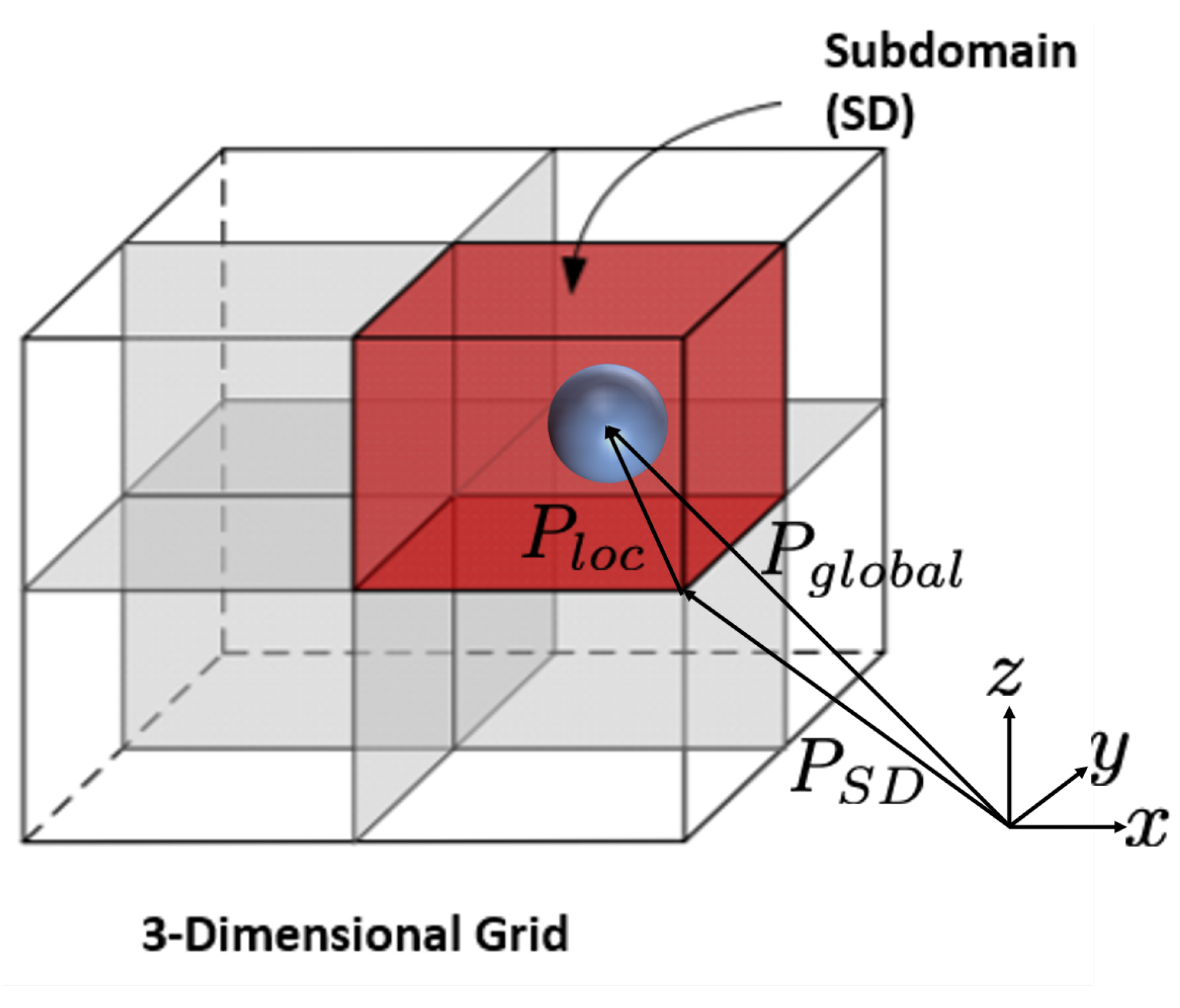
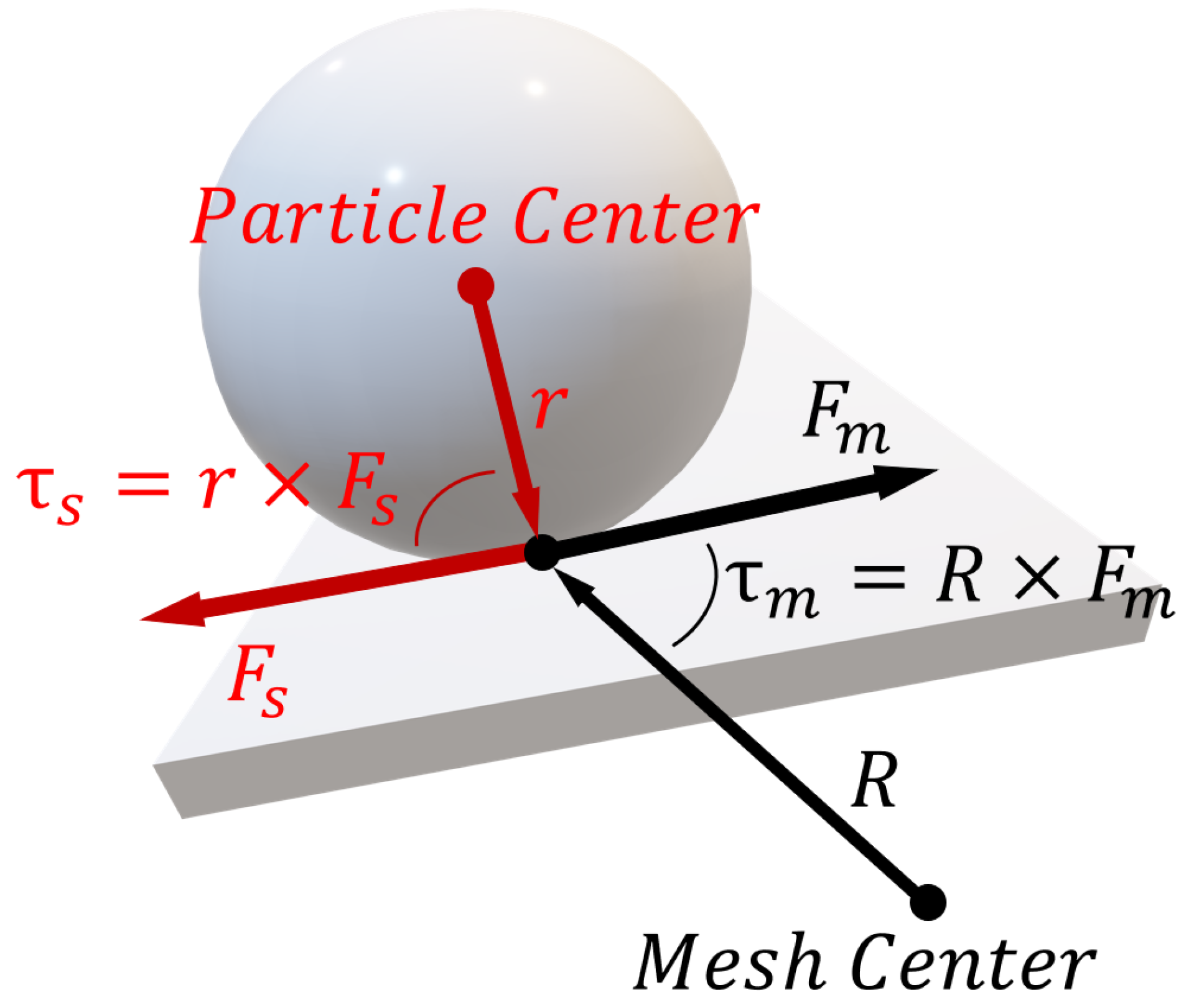
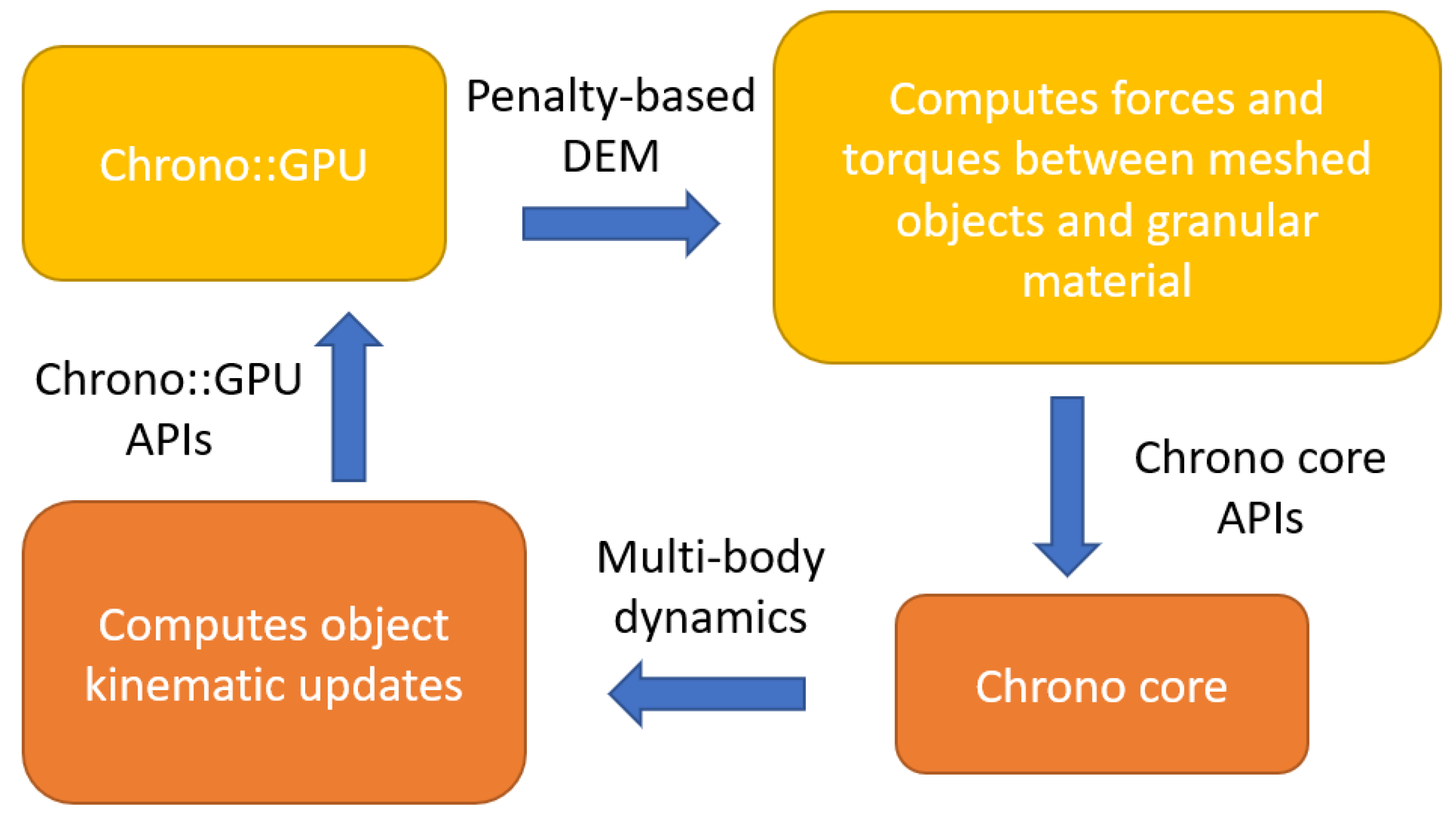




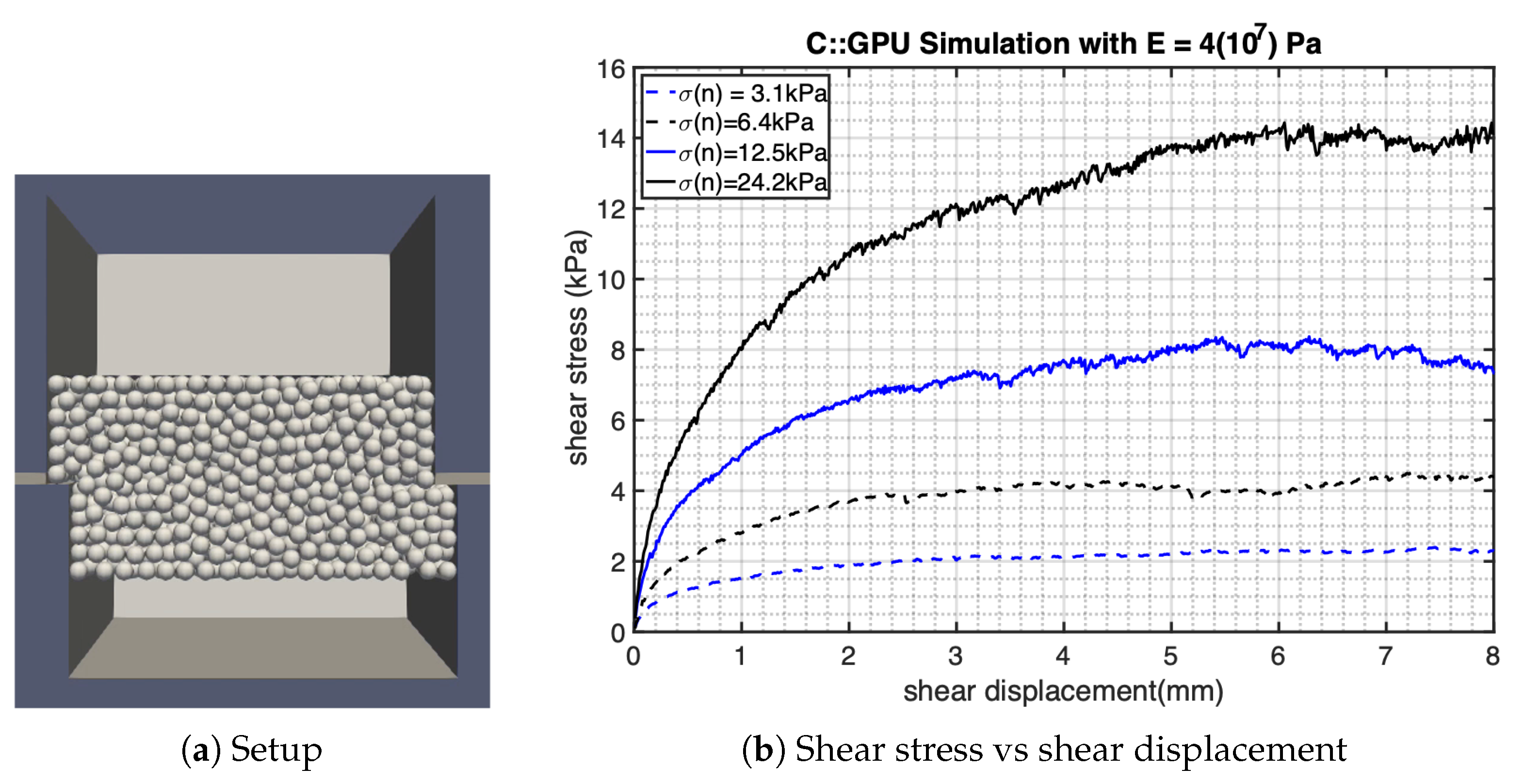



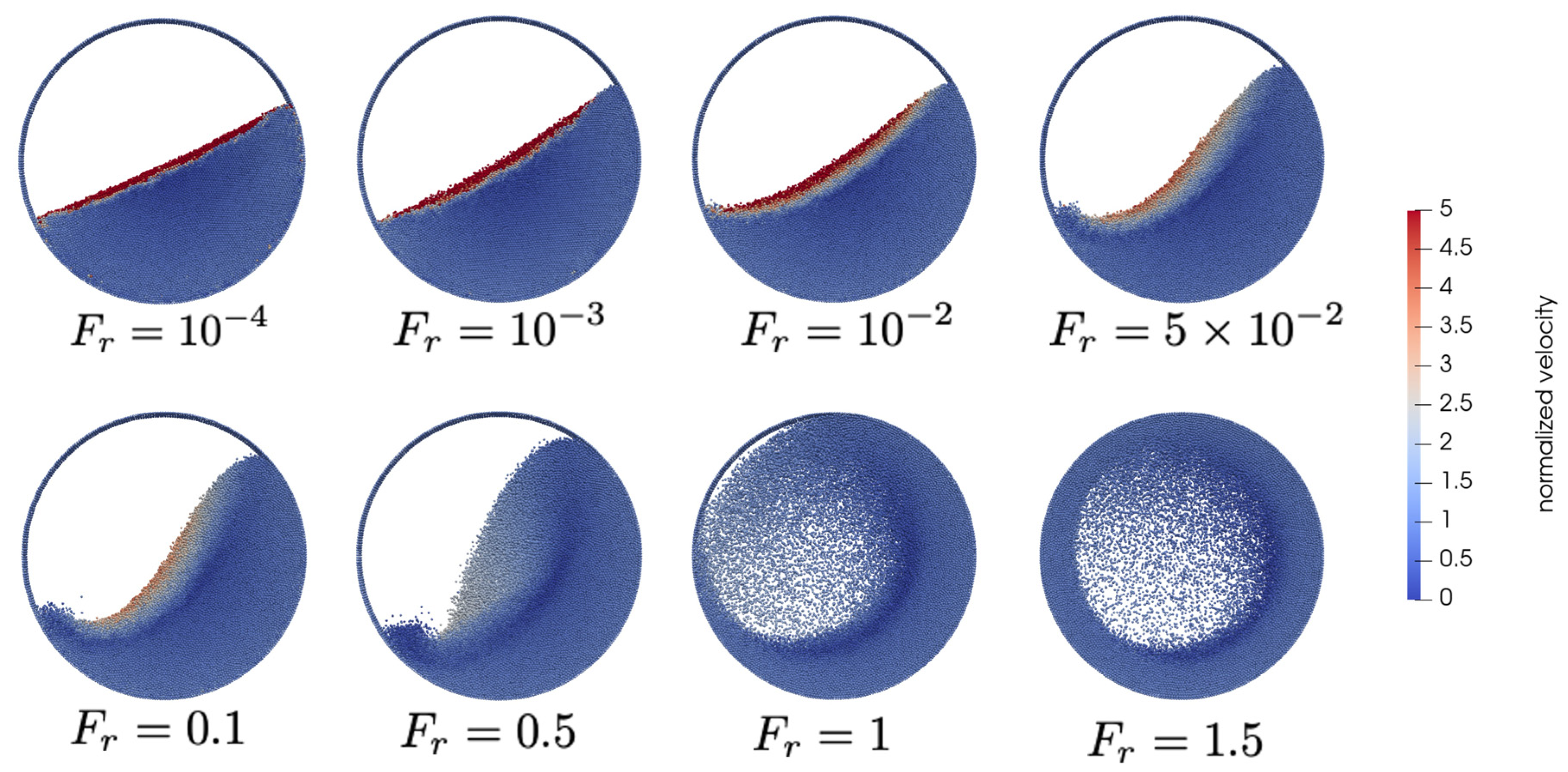







| Data Type | Variable | Memory Type |
|---|---|---|
| Subdomain owner index | Global | |
| Local coordinate within subdomain | Global | |
| Kinematics quantity, friction history, mass, etc | Global | |
| Penetration | Register | |
| Contact force calculation | Register |
| Parameters | Direct Shear | Cratering | Low-Velocity Cratering | Rotating Drum |
|---|---|---|---|---|
| () | 2.55 × 103 | 2.5 × 103 | 2.48 × 103 | 2.5 × 103 |
| R () | 0.3 | 0.1 | 0.5 | 0.0265 |
| E () | 4 × 107 | 7 × 107 | 7 × 108 | 7 × 107 |
| 0.22 | 0.24 | 0.24 | 0.24 | |
| COR | 0.87 | 0.9 | 0.9 | 0.97 |
| 0.18 | 0.3 | 0.16 | 0.16 | |
| 0.4 | [-] | [-] | [-] | |
| [-] | 0.3 | 0.45 | 0.45 | |
| 0 | 0 | 0.09 | 0.09 | |
| () | 1 × 10−5 | 5 × 10−6 | 1 × 10−6 | 1 × 10−6 |
| Parameter | Values |
|---|---|
| Rolling friction coefficient | |
| Gap between bottom spheres |
| Parameter | Mixer | Curiosity |
|---|---|---|
| Particle radius () | Varies | 4.5 × 10−3 |
| Total particle number | Varies | 12,704,030 |
| Particle density (/) | 2.8 × 103 | 2.8 × 103 |
| Step size () | 1 × 10−5 | 2.5 × 10−5 |
| Simulation duration () | 3 | ∼35 |
| Normal force stiffness (N/) | 1 × 105 | 1 × 105 |
| Normal force damping coefficient ( · / ) | 1 × 104 | 5 × 104 |
| Tangential force stiffness (N/) | 1 × 105 | 1 × 105 |
| Tangential force damping coefficient ( · / ) | 1 × 104 | 5 × 103 |
| Friction coefficient | 0.5 | 0.75 |
Publisher’s Note: MDPI stays neutral with regard to jurisdictional claims in published maps and institutional affiliations. |
© 2021 by the authors. Licensee MDPI, Basel, Switzerland. This article is an open access article distributed under the terms and conditions of the Creative Commons Attribution (CC BY) license (https://creativecommons.org/licenses/by/4.0/).
Share and Cite
Fang, L.; Zhang, R.; Vanden Heuvel, C.; Serban, R.; Negrut, D. Chrono::GPU: An Open-Source Simulation Package for Granular Dynamics Using the Discrete Element Method. Processes 2021, 9, 1813. https://doi.org/10.3390/pr9101813
Fang L, Zhang R, Vanden Heuvel C, Serban R, Negrut D. Chrono::GPU: An Open-Source Simulation Package for Granular Dynamics Using the Discrete Element Method. Processes. 2021; 9(10):1813. https://doi.org/10.3390/pr9101813
Chicago/Turabian StyleFang, Luning, Ruochun Zhang, Colin Vanden Heuvel, Radu Serban, and Dan Negrut. 2021. "Chrono::GPU: An Open-Source Simulation Package for Granular Dynamics Using the Discrete Element Method" Processes 9, no. 10: 1813. https://doi.org/10.3390/pr9101813





